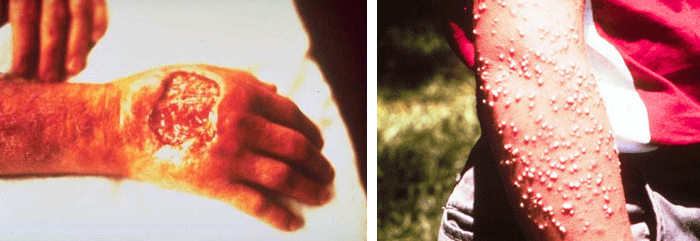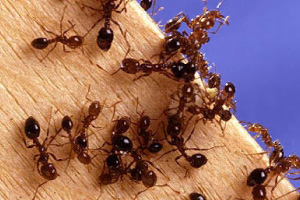Help stop fire ants in their tracks
Our Work | Invasive Insects | Photo: www.antweb.org – CC BY-SA 3.0
Fire Ants are a serious problem for everybody in Australia. These highly invasive ants first turned up in Australia in 2001 at the northern port of Brisbane and have since been found in multiple locations, across Queensland, northern New South Wales and the Murray Darling Basin.
Their stings can kill people and livestock. They can also wipe out entire native ecosystems, turning bustling bushland silent. Australia has a critical opportunity to eradicate fire ants, but urgent action is needed now to prevent them from spreading further.

Left, secondary infection following fire ant stings, photo: Texas Department of Agriculture. Right, pustules resulting from fire ant stings. Photo: Murray S. Blum, The University of Georgia, www.forestryimages.org
What’s the risk?
If we fail to get on top of the current outbreak in Queensland and Northern NSW, modelling shows fire ants will spread to every corner of Australia. Our way of life will be changed forever.
Fire ants spread quickly on their own, however their spread is often accelerated by human assistance. They can reach new areas unexpectedly by stowing away in cargo containers or shipments of potted plants, soil or mulch.
Their ability to form rafts and float on top of water means severe weather and flooding events can also exacerbate their spread.
Once they reach a new area, they can be quite resilient and may take a long time to detect.
Fire ants form rafts in flood waters, following ex-cyclone Alfred in Qld, 2025.
We just have to look at the US to see what would happen to Australia if we fail to eradicate fire ants.
Fire ants were accidentally introduced into Alabama in the 1930s. It was not until 1957 that eradication was attempted but it was too late. They have now spread to Texas, Arkansas, California, Florida, Georgia, Louisiana, Mississippi, New Mexico, North Carolina, Oklahoma, Puerto Rico, South Carolina, Tennessee, Texas, and Virginia.
- They cost US industry and agriculture over $10 billion AUD a year.
- They have caused the death of 85 people, all dying from anaphylactic shock.
- Elderly people in US nursing homes have died after mass stings.
Could this happen in Australia?
Yes. More than 95% of Australia is suitable for fire ant infestation. If left unchecked, they will spread across almost all of the country.
Fire ants might be small, but when their nests are disturbed they rise up in their thousands to swarm and sting you all at once.
Without the regular use of chemical baits, infested parks, gardens and homes become uninhabitable. In the US, 30% to 60% of people in infested areas are stung each year. The stings are painful, hence their name ‘fire’ ants. The alkaloid venom causes pustules and, in some people, allergic reactions.
Fire ants have greater ecological impacts than most ants because they reach extremely high densities. An assessment of their likely impact on 123 animals in southeast Queensland predicted population declines in about 45% of birds, 38% of mammals, 69% of reptiles and 95% of frogs.
These ants damage crops, rob beehives and kill newborn livestock. During dry times they dominate the margins of dams and livestock cannot reach water without being seriously stung.
Australia has too much to lose if we don’t eradicate fire ants.
Tell Prime Minister Anthony Albanese and other leaders that you want fire ants eradicated.
To achieve a fire-ant-free Australia, we need decision-makers to know that thousands of Australians support increased and action and funding for eradication while there’s still time. Email them today.
Why we need to take action
Fire ants are one of the world’s worst invasive species. They are an economic and environmental pest, responsible for killing people in the southern half of the United States where they are a prolific invasive species. They severely impact natural habitats, parks and sporting fields, farms, and livestock.
As well as being an environmental and health hazard, they cost US industry and agriculture a shocking $10 billion AUD a year. If left unchecked, economic modelling shows they could cost Australia over $2 billion annually if we don’t stop the spread.
An independent review found that a major boost of funding is needed over the next decade to successfully eradicate fire ants from South East Queensland. The alternative is unthinkable. If fire ants get out of control Queensland alone faces a 30-year damage bill of $45 billion, dwarfing the cost of eradication.
Shockingly, this could have been prevented. The South East Queensland infestation was almost eradicated in 2003 but failure to conduct broad long-term surveillance allowed the infested area to double between 2004 and 2010. Between 2010 and 2017 there was no long-term funding for the eradication program.
Following significant advocacy efforts, in late 2023 new government fire ant eradication funding was confirmed until 2027. This new funding buys time but more is needed to achieve full eradication in Australia.
The 2024 Australian Senate fire ant inquiry provided 10 recommendations to get fire ant eradication efforts back on track. These include a funding review, a long-term commitment, greater transparency, research and a new independent eradication authority.
To avoid a disastrous fire ant future, the Australian Government must rapidly implement these findings.
Tell Prime Minister Anthony Albanese and other leaders that you want fire ants eradicated.
To achieve a fire-ant-free Australia, we need decision-makers to know that thousands of Australians support increased and action and funding for eradication while there’s still time. Email them today.
We’re the only national environmental advocacy organisation working to stop this national disaster.
With community support we can hold governments to account and push for immediate action.
Please donate today to support urgent action.









